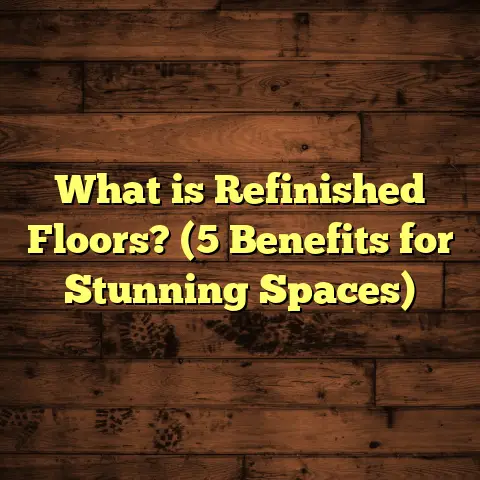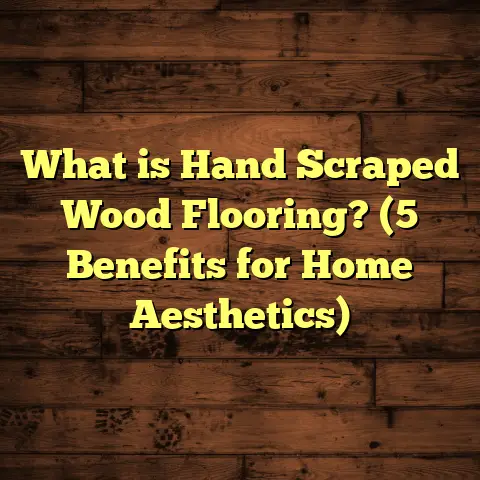What is Deck Flooring Made Of? (5 Essential Materials Explained)
When I first started working with decks, the one thing that stood out was how much easier a project could be when your materials cooperate. I’ve learned the hard way that the choice of deck flooring material doesn’t just influence how good your deck looks but also how long it lasts, how much effort it takes to install, and what kind of maintenance you’ll be signing up for. The easier it is to install, the faster you can enjoy your outdoor space without headaches. So, what exactly is deck flooring made of? This is a question I get asked a lot by homeowners and fellow contractors alike.
Deck flooring is essentially the surface material that forms the walking area of outdoor decks, porches, patios, or even balconies. It’s got to handle sun, rain, snow, foot traffic, and sometimes heavy furniture, all while looking attractive and feeling safe on bare feet. Over the years, I’ve worked with a handful of materials that dominate this space—each with its own story. Let me walk you through five essential deck flooring materials based on my hands-on experience and some solid research.
What is Deck Flooring Made Of?
At its core, deck flooring is the visible, walkable surface layer of an outdoor deck. It can be made from natural materials like wood or modern composites and synthetics designed to mimic wood’s appearance but improve on its weaknesses. The choice of material is crucial because it impacts installation, durability, maintenance requirements, cost, and aesthetics.
Here are five key materials I’ve found to be the most common in deck flooring:
- Pressure-Treated Wood
- Composite Decking
- Natural Hardwood
- PVC Decking
- Aluminum Decking
Each has unique characteristics. I’ll share insights gained from projects spanning simple DIY weekend builds to large commercial installations.
Pressure-Treated Wood: The Tried-and-True Workhorse
What Is Pressure-Treated Wood?
Pressure-treated wood is lumber (commonly pine or fir) that’s been soaked under high pressure with chemical preservatives to protect it from rot, insects, and fungal decay. This process forces chemicals deep into the wood fibers, making it far more durable than untreated wood when exposed to moisture outdoors.
Why It’s So Popular
When I first started out in construction over 15 years ago, pressure-treated wood was everywhere. People loved it because it was affordable and easy to find at almost any hardware store. For homeowners wanting to save money or do their own decks, this was often the natural choice.
I remember helping a friend build his first deck using pressure-treated wood. We didn’t have fancy tools—just a circular saw, drill, and standard screws—and yet the project went smoothly over a weekend. The boards were forgiving to work with and could be cut or shaped easily on site.
Advantages
- Cost-effective: Pressure-treated wood typically costs $2 to $5 per square foot installed.
- Easy to install: No special fasteners or techniques required.
- Widely available: Most lumber yards stock it year-round.
- Strong enough: Good for most residential decking needs.
Challenges From Experience
One of my early mistakes was underestimating the importance of spacing between boards. Moisture trapped between tightly laid boards can cause warping or decay despite treatment. I also learned that not all pressure-treated wood is created equal—some grades have higher chemical retention or better durability ratings.
According to the American Wood Protection Association (AWPA), pressure-treated wood can last 15-20 years outdoors with proper care. However, if you skip sealing or staining regularly, its lifespan can shorten dramatically.
Maintenance Tips From Me
I recommend sealing pressure-treated decks every 2-3 years with a quality water-repellent stain. This helps prevent cracking and splitting caused by sun exposure and moisture cycles. Also, clean your deck annually with specialized wood cleaners to remove mildew and dirt buildup.
Installation Pointers
- Pre-drill holes: Avoid splitting when screwing near board ends.
- Leave 1/8” to 1/4” gap: For drainage and expansion.
- Use corrosion-resistant fasteners: Galvanized or stainless steel screws prevent rust stains.
- Protect cut ends: Apply wood preservative to exposed areas after cutting.
Composite Decking: The Low-Maintenance Marvel
What Is Composite Decking?
Composite decking mixes wood fibers with recycled plastics to create boards that look like wood but resist many of its problems. This hybrid material combines the best of both worlds: the warmth of wood aesthetics with plastic’s durability.
I first encountered composite decking about 10 years ago during a project for a family who wanted a deck that wouldn’t need regular staining or sanding. The installation was straightforward but required some learning since fastening methods differ from traditional wood.
Benefits I’ve Seen
- Minimal upkeep: No annual sealing or staining needed.
- Resistant to rot/insects: Wood fibers are encapsulated in plastic.
- Consistent quality: Factory-made boards avoid knots or splits.
- Variety of colors/textures: More design options than natural wood.
According to NADRA (North American Deck and Railing Association), composite decks can last 25 to 30 years with minimal maintenance—significantly longer than untreated or even pressure-treated wood.
Real-Life Experience Installing Composite Decks
Composite boards often have grooves for hidden fasteners or require proprietary clip systems. Early on, I made the mistake of using regular screws on composite boards, which led to cracking near fastener points. Once I switched to manufacturer-recommended clips and screws designed for composites, installation went much smoother.
Composite decking also expands and contracts with temperature changes more than wood. I learned to leave proper gaps for expansion – usually around 1/4 inch between boards – especially in hotter climates.
Pricing Perspective
Composite decking costs roughly $7-$13 per square foot installed. That’s about double the price of pressure-treated wood but worth it if you want hassle-free maintenance.
Some Downsides I’ve Noticed
Some composites can get hot under direct sunlight compared to natural wood—a common complaint from clients in sunny areas. Also, while they resist fading well, lighter colors may show dirt more visibly.
Natural Hardwood: Timeless Beauty With Challenges
What Is Natural Hardwood Decking?
Natural hardwood decking uses dense tropical woods like Ipe, Tigerwood, Cumaru, or Mahogany that are naturally resistant to insects and decay without needing chemical treatment.
I still recall my first hardwood deck build using Ipe—it was breathtaking but also one of the toughest installs I’ve done. The density makes cutting a workout for blades and pre-drilling essential to prevent splitting.
Why Would You Pick Hardwood?
Clients wanting an authentic wood experience love hardwood’s rich colors and tight grain patterns. Hardwood decks also hold up much longer than treated softwoods—often 40+ years if maintained correctly.
The Forest Products Laboratory reports that tropical hardwoods like Ipe have densities around 1.0 g/cm³ (much higher than pine’s 0.5), explaining their durability but also installation difficulty.
Installation Challenges I Faced
- Tools wear out fast: Carbide-tipped blades are necessary and dull quickly.
- Heavy boards: Handling requires more manpower.
- Pre-drilling mandatory: Screws without pilot holes cause splits.
- Fastener choice matters: Stainless steel screws resist corrosion better than galvanized.
A memorable challenge was cutting through several 1” thick Ipe boards in cold weather—my saw struggled, and we had to switch blades mid-project multiple times!
Maintenance Insights
Hardwood decks need oiling every 6 months or so to maintain color and prevent drying out. I usually recommend penetrating oils like tung or teak oil rather than surface stains.
Without maintenance, hardwood will weather to silver-gray but remain structurally sound. Some clients prefer this natural aging look; others want vibrant finishes requiring upkeep.
Price Tag Reality
Hardwood decking costs $10-$20 per square foot installed—much higher than pressure-treated or composites but justified by longevity and beauty.
PVC Decking: The All-Plastic Solution
What’s Unique About PVC Decking?
PVC decking is 100% plastic polymer (polyvinyl chloride), unlike composites which mix wood fibers with plastic. This means PVC doesn’t absorb moisture at all and won’t rot or support mold growth under any conditions.
I first installed PVC decking at a beach house where salt spray was a constant enemy of traditional decks. The owner loved how the boards never warped or splintered after several seasons.
Benefits From My Experience
- Waterproof: No moisture absorption means no swelling or rotting.
- Fade/stain resistance: Color remains vibrant longer than composites.
- No mold/mildew growth: Great for shady or damp locations.
- Lightweight: Easier handling on site compared to hardwood.
Manufacturers often back PVC decking with warranties of 25-30 years for fading and structural integrity.
Installation Tips Learned Along The Way
PVC boards expand more than composites or wood with temperature fluctuations—up to 1/2 inch over long runs! Leaving adequate gaps is vital; otherwise boards can buckle in heat.
They’re also flexible underfoot compared to rigid hardwoods—a factor that some people love for comfort but others find less solid feeling.
Cutting PVC requires fine-toothed saw blades similar to those used for plastics; rough cuts lead to chipping edges.
Cost Considerations
Typically PVC decking runs $12-$18 per square foot installed, making it pricier than composite but cheaper than premium hardwood.
Aluminum Decking: The Industrial Strength Option
What Is Aluminum Decking?
Aluminum decking consists of coated aluminum panels or planks designed for outdoor floors such as balconies, rooftop decks, or pool areas where durability and slip resistance are paramount.
I’ve worked on commercial projects where aluminum decking was chosen specifically for its fire resistance and zero maintenance requirements.
Strengths I’ve Witnessed
- Longevity: Aluminum decks last 50+ years without rust or structural issues.
- Safety: Excellent traction even when wet reduces slip hazards.
- Fireproof: Non-combustible ideal for wildfire-prone regions.
- Lightweight yet strong: Easier structural support needs compared to concrete patios.
Installation Details
Installing aluminum decking differs from wood-based products: you fasten panels with metal screws into metal or treated wooden framing underneath. Special metal-cutting tools are needed for precise cuts.
While installation might require professionals familiar with metalworking techniques, once installed these decks rarely need repairs or refinishing.
Cost Analysis
Aluminum decking costs $15-$25 per square foot installed — high upfront investment but potentially lowest lifetime cost due to zero maintenance and exceptional durability.
Comparing These Five Deck Flooring Materials Side By Side
| Material | Cost/Sq.Ft Installed | Lifespan (Years) | Maintenance Effort | Installation Difficulty | Appearance | Best Use Case |
|---|---|---|---|---|---|---|
| Pressure-Treated Wood | $2 – $5 | 15 – 20 | Annual sealing/staining | Easy | Natural wood grain | Budget-friendly DIY projects |
| Composite Decking | $7 – $13 | 25 – 30 | Low (periodic washing) | Moderate | Wood-like textures/colors | Low-maintenance residential |
| Natural Hardwood | $10 – $20 | 40+ | Biannual oiling | Challenging | Rich natural hardwood | Premium aesthetic projects |
| PVC Decking | $12 – $18 | 25 – 30 | Very low | Moderate | Smooth/colorful options | Coastal/wet climates |
| Aluminum Decking | $15 – $25 | 50+ | None | Specialized | Modern industrial look | Commercial/high safety areas |
Personal Reflections on Choosing Deck Flooring
After years of trial and error—and some costly mistakes—I’ve come to appreciate how vital matching deck materials with your lifestyle and environment really is. For example:
- In humid climates where mold grows fast, I avoid untreated woods entirely.
- For coastal homes like the one I mentioned earlier, PVC or aluminum saved the day by resisting salt damage.
- If clients want warm natural beauty and don’t mind some work maintaining it, hardwood becomes my recommendation every time.
- For budget-conscious folks who want a quick weekend project? Pressure-treated wood wins hands down.
- And if you want longevity with minimal fuss? Composite decking often hits the sweet spot.
One memorable case study involved a homeowner who initially installed pressure-treated pine only to have it warp badly after two seasons due to poor spacing during installation. We replaced it with composite decking two years later—saving them future headaches and maintenance costs while boosting property value noticeably.
How These Materials Compare With Alternatives Like Stone or Concrete
Sometimes people ask me why not just skip decking altogether in favor of concrete patios or stone pavers? While those alternatives have their place (especially for ground-level patios), they don’t quite deliver the same feel underfoot as deck flooring materials do:
- Wood-based decks offer warmer surfaces on bare feet than stone/concrete which stays cold.
- Decks can be elevated easily over uneven terrain without heavy excavation.
- Wood/composite decks provide more design flexibility in shape and texture.
- Concrete requires expansion joints and can crack; decks flex slightly reducing breakage risk.
Each solution fits different needs; if you want a softer feel with easy elevation options—deck materials win out every time in my opinion.
Final Thoughts: What Makes the Best Deck Flooring?
Choosing what deck flooring is made of comes down to balancing these factors:
- Budget constraints
- Maintenance willingness
- Local climate conditions
- Desired aesthetics
- Installation skill level
My personal preference? For most residential projects where homeowners want something both beautiful and low-maintenance without breaking the bank—I lean toward composite decking as the go-to choice nowadays. But if you want natural beauty and are ready for upkeep—Ipe hardwood is unbeatable in charm and longevity.
I hope sharing my stories, data points, installation tips, and case studies gives you a clearer picture when deciding what your next deck should be made from. Building decks has taught me there’s no one-size-fits-all answer—it’s about what fits your project best!
If you want help estimating costs based on local labor/material rates or want advice tailored to your climate zone, tools like FloorTally have been invaluable in my workflow—they let me visualize costs upfront so there are no surprises down the road.
Whatever path you choose—happy decking!
If you want me to expand further on any specific section like installation techniques for a particular material or maintenance schedules in different climates, just ask!





